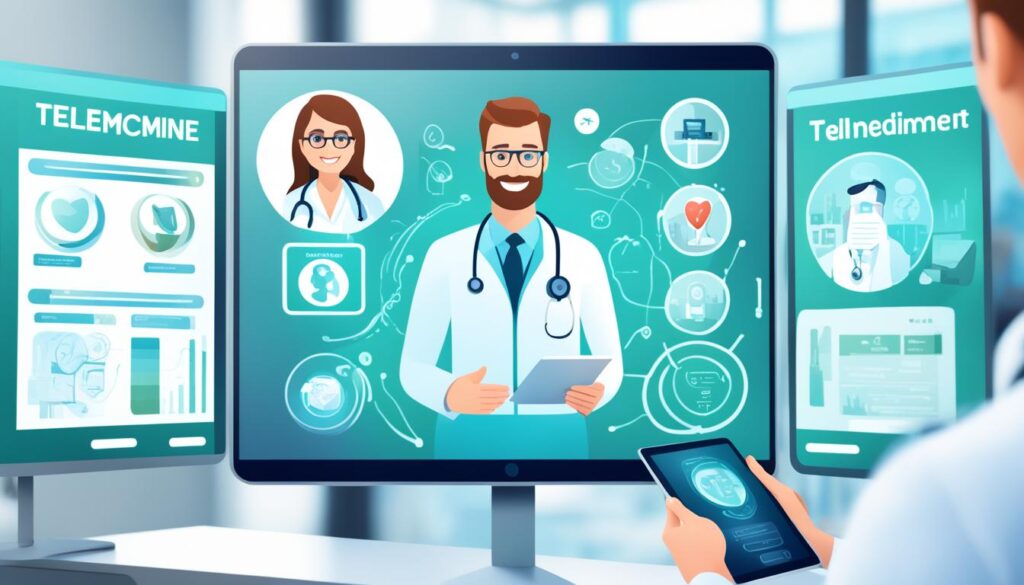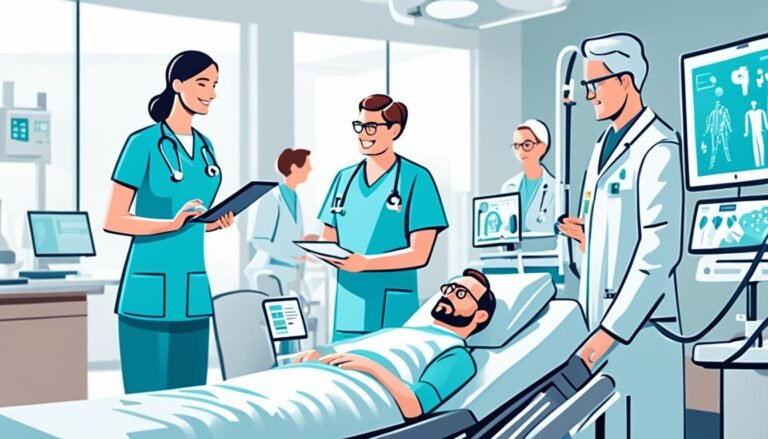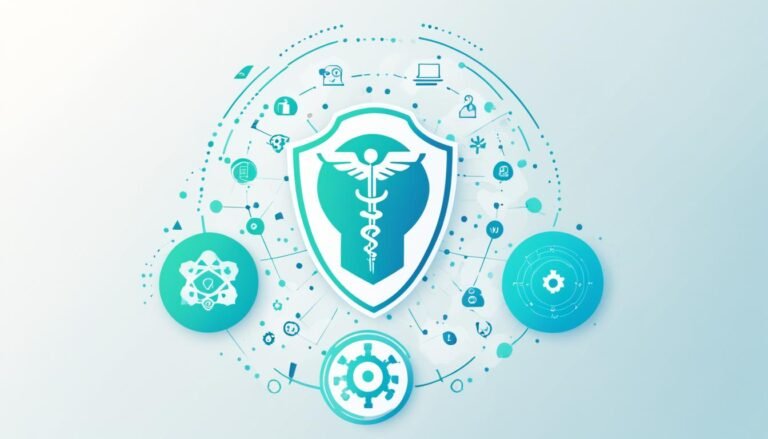Telemedicine Explained: Guide to Virtual Care
Did you know that nearly 76% of hospitals in the U.S. now offer telemedicine? This shows a big change toward online healthcare, making medical advice easier to get. Now, you can talk to doctors from home, thanks to virtual visits. This change has made remote care a key part of healthcare.
Virtual care is not just advanced technology; it’s a vital service for those needing timely medical help without travel limits. Telemedicine Explained is about improving how we get medical care. It’s vital for managing ongoing health issues, mental health support, or getting medical advice. With more people using telemedicine, virtual visits have become essential for overcoming the challenges of distance and time.
Key Takeaways
- The surge of telemedicine use in hospitals indicates its critical role in modern healthcare.
- Virtual doctor visits provide a convenient, no-travel solution to receiving medical care.
- Telemedicine Explained highlights the ease of accessing care from any location.
- Telemedicine consultations offer a practical choice for a variety of healthcare needs.
- Remote healthcare options are pivotal for patient-centric, flexible care delivery.
- Virtual care continues to break down barriers to healthcare access and availability.
The Evolution and Importance of Telemedicine in Modern Healthcare
The story of telemedicine technology is one filled with change, leading the way in virtual healthcare evolution. It started small but has grown into something much bigger. It has changed how we get medical care. Each step forward brings more telehealth benefits. It shows us a future where advanced telemedicine solutions are common.
Telemedicine has revolutionized healthcare by offering virtual consultations, which make medical care more accessible and efficient. It allows patients to connect with healthcare providers remotely, reducing wait times and travel. In telemedicine Illinois, this technology is helping underserved communities by offering convenient, timely care, and it has become particularly valuable for managing chronic conditions and routine follow-ups.
The Pioneering Phases of Telemedicine Technology
Telemedicine first helped those in far-off places get medical advice quickly. It used to rely on phone calls but grew with the internet. Video chats and detailed remote consultations came next. This innovation paved the way for today’s diverse telemedicine services.
The Impact of Telemedicine on Healthcare Accessibility and Efficiency
Telemedicine has greatly improved how we access healthcare. It’s a big help for people in remote areas or those who can’t easily travel. It proves how far we’ve come in delivering health services. This was especially clear during the COVID-19 pandemic. Then, virtual appointments were essential.
| Telemedicine Advancements | Impact on Healthcare |
|---|---|
| Videoconferencing | Facilitates real-time communication between patients and providers |
| Store-and-forward Imaging | Allows for asynchronous sharing of patient data and images for diagnosis |
| Streaming Media | Enables continuous education and updates for patients and healthcare professionals |
| Advanced Telecommunications | Improves healthcare coverage and management of chronic diseases |
Telemedicine is shaping the future of health management. It brings unmatched access, efficiency, and care focused on the patient. It goes beyond old limits, shaping a world where healthcare meets everyone’s personal needs.
Understanding Telemedicine: Defining the Digital Delivery of Care
Technology has really changed healthcare, and telemedicine platforms are leading the way. Telemedicine services make it easy for patients and doctors to connect, no matter where they are. The key to digital healthcare delivery is providing clear communication through technology.
One key tool is videoconferencing. It lets patients and doctors meet face-to-face without being in the same place. These online visits are just like real ones, offering great advice and diagnoses without losing quality.
Telehealth is more than just a video call—it’s an innovative approach to extending healthcare services to anyone, regardless of their physical location.
Another important method in telemedicine is store-and-forward. It lets doctors look at medical images or recordings later on. This is really helpful for specialists who need to take a close look and reply when they can.
Digital healthcare delivery also includes remote patient monitoring. This lets doctors keep an eye on health data regularly. This data usually comes from wearable devices that track and send information, like heart rates or sugar levels, to doctors.
E-visits and mobile health (mHealth) apps are changing how we think about health care. They let people manage their health using their own devices. These tools not only make medical advice more accessible but also let individuals control their health outside hospitals or clinics.
Here’s a quick look at what makes up digital healthcare through telemedicine:
- Videoconferencing for real-time doctor-patient chats
- Store-and-forward technology for checking medical info
- Monitoring health data from afar for ongoing care
- E-visits and mHealth apps for managing health personally
Telemedicine platforms are shaping the future of healthcare in amazing ways. They bridge the gap between patients and medical expertise. This results in a more effective and easy-to-access digital healthcare system.
Advantages of Telemedicine for Patients and Providers
Healthcare has changed with the rise of telemedicine benefits. This blend of tech and care improves experiences for patients and providers. It makes healthcare impactful through virtual healthcare services.
Expanding Access to Remote Healthcare Options
Access to care for those in remote areas has greatly improved. Before, if you lived far away or couldn’t travel, getting healthcare was tough. Now, virtual doctor visits connect doctors and patients, no matter the distance.
Telehealth Benefits: Conveniences Provided by Virtual Doctor Visits
Telemedicine makes getting healthcare easier. It saves patients from traffic and long waits. It helps doctors see more patients with less hassle. This makes care better for everyone.
Reducing Healthcare Costs Through Telemedicine Solutions
Cutting costs in healthcare is crucial. Telemedicine solutions help do this by reducing the need for in-person visits. This saves money and is better for the environment. It also helps manage ongoing health issues efficiently.
Types of Telemedicine Platforms and How They Transform Care
Telemedicine services are growing fast, making it easier to get medical care online. Each platform has its special way of making healthcare smooth and effective for those far away.
| Platform Type | Description | Impact on Care |
|---|---|---|
| Real-time Videoconferencing | Allows synchronous doctor-patient consultation via video chat. | Facilitates immediate communication and visual assessment. |
| Store-and-Forward Platforms | Enables the asynchronous sharing of patient data and records for review. | Provides flexibility for providers to evaluate patient information. |
| Remote Patient Monitoring Systems | Tracks and transmits patient’s health data in real-time to healthcare professionals. | Promotes proactive management of chronic conditions and overall health. |
| E-Visits via Patient Portals | Secure online spaces for patients to report issues and receive advice. | Increases patient engagement and streamlines follow-up procedures. |
| Mobile Health Apps | Empowers patients with tools for self-management of their health. | Boosts patient autonomy and promotes consistent health monitoring. |
Telemedicine platforms are key to switching to digital healthcare. They offer custom care to meet different patient needs. Telemedicine links patients and doctors across distances while keeping care ongoing and smooth.
By bringing together advanced technology and medical expertise, telemedicine platforms are reshaping the future of healthcare.
- Real-time videoconferencing enhances doctor-patient interactions through live visual and auditory communication.
- Store-and-forward platforms grant healthcare providers the flexibility to review patient information without the restrictions of scheduling.
- Remote patient monitoring systems allow for continuous observation of health indicators, providing invaluable data for treatment adjustments.
- E-visits accommodate quick consultations, prescription renewals, and routine follow-ups conveniently through patient portals.
- Mobile health apps offer the tools necessary for individuals to proactively manage their health, encouraging a sense of empowerment.
In this time, value is put on being efficient and easy to access. Telemedicine services lead the way, sparking innovation in patient care. Digital healthcare via telemedicine ensures not just reliable medical service access but also boosts patient happiness and involvement.
Telemedicine Consultation: Preparing for Your Virtual Doctor Visit
Getting ready for telemedicine involves a few steps to make sure it’s as good as seeing a doctor in person. By preparing early, you make your online doctor visit comfortable and efficient. Let’s talk about how to set up your space and what will happen during your telemedicine appointment.
Choosing the Right Environment for Your Online Consultation
First, find a quiet, private place for your telemedicine visit. Make sure it’s a spot where noise won’t interrupt you. It should also be well-lit, so your doctor can see you well. This makes your consultation feel professional, even at home.
Check your device’s audio and video before your appointment to make sure they work. A good internet connection is also key. This helps your telehealth visit run smoothly, without tech problems.
What to Expect During a Virtual Healthcare Session
A telemedicine visit is a lot like a regular doctor’s appointment. Start by getting familiar with the telemedicine platform. Knowing how to use it can save time and reduce stress. You’ll also do a quick check-in with office staff before seeing your doctor.
In your session, talk openly about your health issues and ask questions, just like you would in person. Even though it’s online, the quality of care should be the same. Knowing what to expect can make your telemedicine visit go smoothly.
Telemedicine Explained: Your Comprehensive Guide to Virtual Healthcare
The world of virtual healthcare services is growing fast. It’s important to see how this change affects our health and wellness. This piece will give you a deep look into the power of telehealth benefits. You’ll get a comprehensive telemedicine guide that shows how easy and useful it can be.
Telehealth is becoming more common, offering high-quality healthcare online. Here’s why virtual healthcare stands out:
Telemedicine provides a healthcare solution that’s innovative and meets the needs of patients and healthcare providers alike.
A detailed comprehensive telemedicine guide helps you know everything about telehealth. This includes how it works and the benefits it brings. Let’s explore what makes a great virtual healthcare experience.
- Learning about different telemedicine services
- Understanding how telemedicine can be used in various situations
- Getting comfortable with using virtual care platforms
It’s more than just being convenient. It’s about taking a complete approach to healthcare that fits our digital lives. To show what virtual healthcare involves, look at this table. It mixes tech and care in a useful way:
| Service Aspect | Feature | Telehealth Benefit |
|---|---|---|
| Accessibility | Remote Consultations | Healthcare reaches everywhere, going beyond physical boundaries |
| Convenience | On-Demand Appointments | Scheduling that works with all kinds of lifestyles |
| Cost-Effectiveness | Reduced Overheads | Lowers the need to spend on travel and buildings |
| Comprehensiveness | Diverse Specialties | Access to many medical fields on one platform |
This comprehensive telemedicine guide signals a future where virtual healthcare services mean high-quality, easy, and widespread care. In this future, telehealth benefits are a core part of worldwide healthcare.

With this guide, you’re ready to join a healthcare change. This change will bring better access, lower costs, and care tailored to each person, no matter where they are. Let’s welcome the future of virtual healthcare. It’s going to make a big difference in medicine and how patients feel better.
Integrating Telemedicine Technology into Chronic Disease Management
Chronic disease management is changing fast because of new telemedicine technology. Now, patients can manage their health conditions at home through telehealth monitoring. This makes healthcare more streamlined and care plans more tailored and flexible.
Virtual health tools let doctors keep a close watch on patient health continuously. When patients share their data with remote devices, doctors can quickly make informed decisions. This reduces risks related to chronic diseases.
Monitoring Long-Term Health Conditions via Telehealth
Telehealth monitoring is vital for patients managing their health. It lets them track health signs and talk to doctors in real-time. This can lead to better health and fewer hospital visits.
Personalizing Care Plans with Virtual Health Tracking
Care plans can now be personalized outside of regular clinics. With virtual health tools, treatments can be tailored using detailed data from wearable devices and telemedicine. This brings patient care to a new level.
| Health Metric | Monitoring Method | Benefits |
|---|---|---|
| Blood Pressure | Automatic cuffs with Bluetooth connectivity | Enables early detection of cardiovascular risks |
| Blood Sugar Levels | Continuous glucose monitoring systems | Promotes better glycemic control for diabetic patients |
| Heart Rate | Wearable fitness trackers | Helps in identifying arrhythmias and other heart conditions |
| Activity Levels | Smartphone health apps and pedometers | Encourages mobility and exercise in daily routines |
| Sleep Patterns | Wearable sleep trackers | Aids in the management of sleep disorders |
In conclusion, telemedicine technology is transforming chronic disease management. It’s leading to care that is more responsive, efficient, and centered on the patient. By using these tools, we are closer to controlling long-term health conditions effectively.
Legal and Regulatory Frameworks Governing Telemedicine Services
The growth of telemedicine has led to detailed telemedicine legal frameworks. These are made to protect patients and the quality of online care. As healthcare delivery changes, understanding these laws is key for everyone in telehealth.
Telehealth laws cover licensure, payment, and patient privacy. Providers must have a license in the patient’s state. They also need to know about payment policies, which can vary. These regulations help keep online care trustworthy across the country.
Virtual care standards set the protocols and quality for telehealth services. They make sure patients get good care, no matter the distance. Following the Health Insurance Portability and Accountability Act (HIPAA) is crucial. It protects patient information.
Following telemedicine laws shows a promise to keep patients safe and provide quality care.
Telehealth rules are always getting updates to match telemedicine’s fast growth. This means healthcare workers must keep learning. It’s important that laws keep up with telemedicine. This ensures that online care stays up-to-date with rules and standards.
Finding a balance between quick tech growth in healthcare and strong legal safety is tricky. But, refining telemedicine laws and rules is vital. It helps telemedicine be a trusted way to get healthcare.
By knowing and following the laws, healthcare workers can give good online care and stay within legal limits. The future of telehealth depends on aligning these rules. This will make healthcare accessible, secure, and effective for everyone.
Ensuring Privacy and Security in Telemedicine Consultations
Telemedicine is gaining ground in healthcare, and with it comes the need for telemedicine privacy. HIPAA compliance and secure telehealth communication are crucial. They build trust and ensure virtual care platforms protect data and uphold ethics.
HIPAA Compliance in Virtual Care Platforms
HIPAA compliance is a must in telehealth for patient data safety. It’s essential for all virtual care platforms. Health providers should choose services that provide strong encryption and commit to HIPAA with formal agreements.
Patient and Provider Responsibilities for Secure Telehealth Communication
Keeping telehealth data safe is a team effort that includes patient responsibilities and provider obligations. Providers need to teach patients about privacy risks and use strong security tools. Patients, in turn, should learn about telehealth and consent to use it wisely.
Here’s a detailed table of what each side needs to do to make sure telemedicine is secure and works well:
| Stakeholder | Responsibilities | Actions |
|---|---|---|
| Providers |
|
|
| Patients |
|
|
By taking these steps, both healthcare providers and patients can ensure a secure telehealth communication environment. This makes virtual visits safe and trusted. The push for better telehealth security is ongoing, aiming for greater privacy and protection.
Overcoming Challenges and Limitations of Telemedicine
Telemedicine brings great promise but it also faces some tough challenges. Telemedicine challenges like limited access to technology can lead to unfair situations. The lack of in-person exams virtual care limitations may make it hard to diagnose correctly. Also, some patients might find it hard to use digital care tools.
To deal with these issues, there’s a lot of work being done on making telemedicine better and more accessible for everyone. These efforts are key to making sure telemedicine can reach and help more people.
Here’s a table showing some key areas where improvements are happening:
| Challenge | Current Limitation | Action for Improvement |
|---|---|---|
| Technology Access | Limited availability in underserved areas. | Implementing government and private sector initiatives to provide devices and internet access. |
| Diagnostic Capabilities | Restrictions without in-person exams. | Developing more sophisticated diagnostic tools and AI-based analysis for remote assessments. |
| Patient Readiness | Varying comfort levels with technology use. | Creating educational programs and user-friendly interfaces to enhance digital literacy. |
| Patient-Provider Relationship | Lack of in-person interaction can impact rapport. | Utilizing enhanced communication techniques and training providers in telepresence skills. |
| Regulatory Environment | Complex and varying telemedicine laws. | Advocating for unified, standardized regulations that facilitate cross-state care while ensuring safety. |
The challenges and limitations of telemedicine are real. Yet, there’s strong momentum in making things better. With commitment to innovation and solving problems, the future of telemedicine is bright. It’s headed towards offering quality care that’s accessible and effective for everyone.
Future Trends and Innovations in Telemedicine Solutions
The world of telemedicine is growing fast, bringing us into a time where virtual healthcare innovations are crucial. We are moving towards a future where the mix of AI in telemedicine and machine learning advancements leads to better patient care and more efficient operations.
The Role of AI and Machine Learning in Enhancing Telehealth
AI is already changing telemedicine, making it better than before. With the help of machine learning, doctors can make more accurate decisions. This technology is key to improving the quality and personalization of telehealth.
- Improved diagnostic accuracy through pattern recognition.
- Refinement of patient treatment plans by analyzing past outcomes.
- Predictive health analytics to forecast potential epidemics or disease flare-ups.
Global Reach: Telemedicine’s Expanding Horizons
The global reach of telemedicine makes healthcare accessible everywhere. It’s especially helpful in places that lack good health services. Expanding telehealth horizons means more people get the care they need, no matter where they are.
| Aspect | Impact on Developed Countries | Impact on Developing Countries |
|---|---|---|
| Healthcare Delivery | Enhances existing structures & integrates specialized services | Provides basic medical care & specialist consultations |
| Healthcare Access | Reduces geographical & time barriers | Lays foundations for consistent, reliable medical access |
| Economic Impact | Lowers costs & optimizes resource allocation | Enables affordable care & minimizes infrastructure investment |
Virtual healthcare innovations are starting to even the playing field in healthcare. They make specialized care available to everyone. This movement isn’t just about new technology. It’s about changing society to make health and wellness accessible across the globe.
Conclusion
We’ve learned a lot about telemedicine together. It’s a key part of the change happening in healthcare. This journey showed us how telemedicine makes health care better. It helps more people get the care they need, in new and efficient ways. This is all about putting patients first.
Technology is making telemedicine even better. It means health care can reach you, no matter where you are. No one has to be left out because they live far away. Telemedicine brings hope. It shows us a future where everyone can get good health care.
Telemedicine is just starting to grow. Every new tech improvement makes it even more important. It’s changing health care in big ways. Now, getting help can be as easy as tapping a screen. And we know more good changes are coming. Telemedicine will keep getting better, making health care better for everyone.





